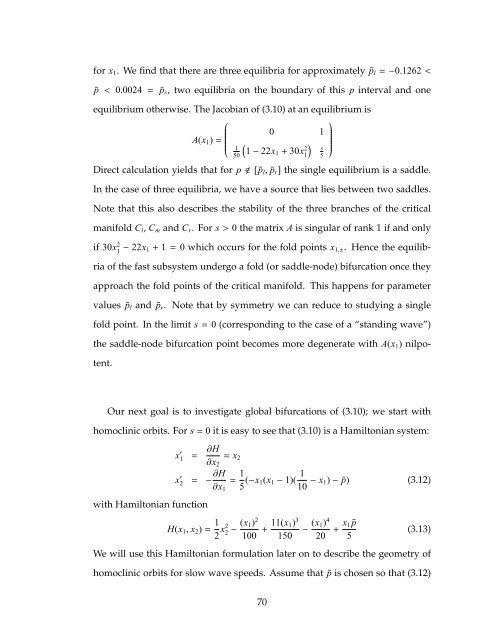multiple time scale dynamics with two fast variables and one slow ...
multiple time scale dynamics with two fast variables and one slow ...
multiple time scale dynamics with two fast variables and one slow ...
You also want an ePaper? Increase the reach of your titles
YUMPU automatically turns print PDFs into web optimized ePapers that Google loves.
for x1. We find that there are three equilibria for approximately ¯pl=−0.1262<<br />
¯p < 0.0024 = ¯pr, <strong>two</strong> equilibria on the boundary of this p interval <strong>and</strong> <strong>one</strong><br />
equilibrium otherwise. The Jacobian of (3.10) at an equilibrium is<br />
⎛<br />
0 1<br />
A(x1)=<br />
⎜⎝<br />
<br />
1 1−22x1+ 30x 50<br />
2<br />
⎞<br />
<br />
s ⎟⎠<br />
1 5<br />
Direct calculation yields that for p[ ¯pl, ¯pr] the single equilibrium is a saddle.<br />
In the case of three equilibria, we have a source that lies between <strong>two</strong> saddles.<br />
Note that this also describes the stability of the three branches of the critical<br />
manifold Cl, Cm <strong>and</strong> Cr. For s>0 the matrix A is singular of rank 1 if <strong>and</strong> only<br />
if 30x2 1− 22x1+ 1=0 which occurs for the fold points x1,±. Hence the equilibria<br />
of the <strong>fast</strong> subsystem undergo a fold (or saddle-node) bifurcation once they<br />
approach the fold points of the critical manifold. This happens for parameter<br />
values ¯pl <strong>and</strong> ¯pr. Note that by symmetry we can reduce to studying a single<br />
fold point. In the limit s=0 (corresponding to the case of a “st<strong>and</strong>ing wave”)<br />
the saddle-node bifurcation point becomes more degenerate <strong>with</strong> A(x1) nilpo-<br />
tent.<br />
Our next goal is to investigate global bifurcations of (3.10); we start <strong>with</strong><br />
homoclinic orbits. For s=0 it is easy to see that (3.10) is a Hamiltonian system:<br />
x ′<br />
1<br />
x ′<br />
2<br />
= ∂H<br />
∂x2<br />
<strong>with</strong> Hamiltonian function<br />
= −∂H<br />
∂x1<br />
= x2<br />
= 1<br />
5 (−x1(x1− 1)( 1<br />
10 − x1)− ¯p) (3.12)<br />
H(x1, x2)= 1<br />
2 x2<br />
2<br />
3 4<br />
(x1) 11(x1) (x1)<br />
2− + −<br />
100 150 20 + x1 ¯p<br />
5<br />
(3.13)<br />
We will use this Hamiltonian formulation later on to describe the geometry of<br />
homoclinic orbits for <strong>slow</strong> wave speeds. Assume that ¯p is chosen so that (3.12)<br />
70
















